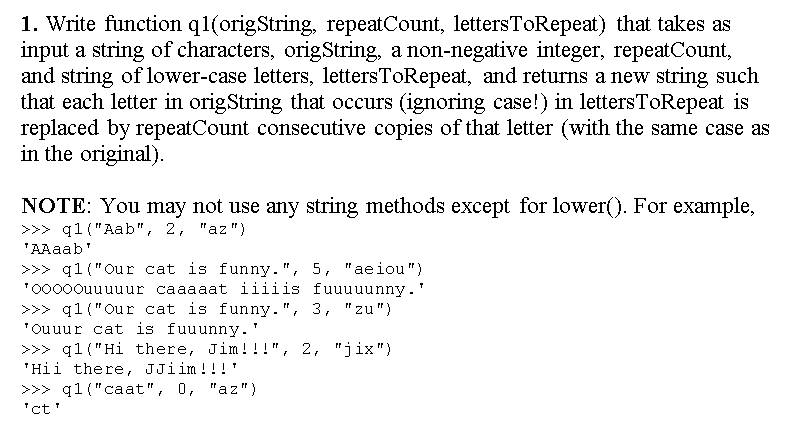1. Write function q1(origString, repeatCount, lettersToRepeat) that takes as input a string of characters, origString, a non-negative integer, repeatCount, and string of lower-case letters, lettersToRepeat, and returns a new string such that each letter in origString that occurs (ignoring case!) in lettersToRepeat is replaced by repeatCount consecutive copies of that letter (with the same case as in the original). NOTE: You may not use any string methods except for lower(). For example, >>> q1 ("Aab", 2, "az ") "AAaab' >>> q1("Our cat is funny.", 5, "aeiou") "0000ouuuuur caaaaat iiiiis fuuuuunny." >>> q1 ("Our cat is funny.", 3, "zu") "Ouuur cat is fuuunny.' >>> q1("Hi there, Jim!!!", 2, "jix") "Hii there, JJiim !!!' >>> q1 ("caat", 0, "az") 'ct'
1. Write function q1(origString, repeatCount, lettersToRepeat) that takes as input a string of characters, origString, a non-negative integer, repeatCount, and string of lower-case letters, lettersToRepeat, and returns a new string such that each letter in origString that occurs (ignoring case!) in lettersToRepeat is replaced by repeatCount consecutive copies of that letter (with the same case as in the original). NOTE: You may not use any string methods except for lower(). For example, >>> q1 ("Aab", 2, "az ") "AAaab' >>> q1("Our cat is funny.", 5, "aeiou") "0000ouuuuur caaaaat iiiiis fuuuuunny." >>> q1 ("Our cat is funny.", 3, "zu") "Ouuur cat is fuuunny.' >>> q1("Hi there, Jim!!!", 2, "jix") "Hii there, JJiim !!!' >>> q1 ("caat", 0, "az") 'ct'
Database System Concepts
7th Edition
ISBN:9780078022159
Author:Abraham Silberschatz Professor, Henry F. Korth, S. Sudarshan
Publisher:Abraham Silberschatz Professor, Henry F. Korth, S. Sudarshan
Chapter1: Introduction
Section: Chapter Questions
Problem 1PE
Related questions
Question
Python Help me please

Transcribed Image Text:1. Write function q1(origString, repeatCount, lettersToRepeat) that takes as
input a string of characters, origString, a non-negative integer, repeatCount,
and string of lower-case letters, lettersToRepeat, and returns a new string such
that each letter in origString that occurs (ignoring case!) in lettersToRepeat is
replaced by repeatCount consecutive copies of that letter (with the same case as
in the original).
NOTE: You may not use any string methods except for lower(). For example,
>>> q1 ("Aab", 2, "az")
"AAaab'
>>> q1 ("Our cat is funny. ", 5, "aeiou")
"0000ouuuuur caaaaat iiiiis fuuuuunny.'
>>> q1 ("Our cat is funny.", 3, "zu")
"Ouuur cat is fuuunny.'
>>> q1 ("Hi there, Jim!!!", 2, "jix")
"Hii there, JJiim !!!'
>>> q1 ("caat", 0, "az")
'ct'
Expert Solution
This question has been solved!
Explore an expertly crafted, step-by-step solution for a thorough understanding of key concepts.
This is a popular solution!
Trending now
This is a popular solution!
Step by step
Solved in 2 steps with 2 images

Recommended textbooks for you

Database System Concepts
Computer Science
ISBN:
9780078022159
Author:
Abraham Silberschatz Professor, Henry F. Korth, S. Sudarshan
Publisher:
McGraw-Hill Education

Starting Out with Python (4th Edition)
Computer Science
ISBN:
9780134444321
Author:
Tony Gaddis
Publisher:
PEARSON

Digital Fundamentals (11th Edition)
Computer Science
ISBN:
9780132737968
Author:
Thomas L. Floyd
Publisher:
PEARSON

Database System Concepts
Computer Science
ISBN:
9780078022159
Author:
Abraham Silberschatz Professor, Henry F. Korth, S. Sudarshan
Publisher:
McGraw-Hill Education

Starting Out with Python (4th Edition)
Computer Science
ISBN:
9780134444321
Author:
Tony Gaddis
Publisher:
PEARSON

Digital Fundamentals (11th Edition)
Computer Science
ISBN:
9780132737968
Author:
Thomas L. Floyd
Publisher:
PEARSON

C How to Program (8th Edition)
Computer Science
ISBN:
9780133976892
Author:
Paul J. Deitel, Harvey Deitel
Publisher:
PEARSON

Database Systems: Design, Implementation, & Manag…
Computer Science
ISBN:
9781337627900
Author:
Carlos Coronel, Steven Morris
Publisher:
Cengage Learning

Programmable Logic Controllers
Computer Science
ISBN:
9780073373843
Author:
Frank D. Petruzella
Publisher:
McGraw-Hill Education